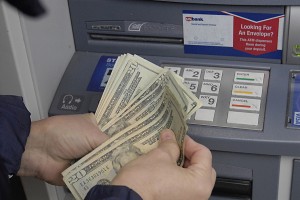Suddenly taking on the role of dark horse, Apple Inc. (NASDAQ:AAPL) shattered Bloomberg L.P.’s gloomy predictions with record-breaking second quarter profits in yesterday’s quarterly report. Just as Apple’s slightly weaker than predicted Q1 earnings sent its stock prices into a nosedive, so yesterday’s unexpectedly positive report caused the Cupertino firm’s shares to rise sharply. The trend continues this morning, with prices already more than 7% higher than opening, far outstripping the overall performance of the NASDAQ (+0.10%) or technology stock in general (+0.37%).
The electronics titan’s $45.7 billion in second quarter revenues were $2.1 billion higher than revenues from 2013’s Q2 results, and $2.1 billion higher than the rather pessimistic forecast offered by Bloomberg yesterday morning, too. Analysis of the data reveals a number of interesting things about Apple’s (AAPL) unexpected success, including what may be the reason for the underestimate.
 Bloomberg’s predictions made no mention of service revenues, which is probably the core error explaining the company’s failure to anticipate Apple Inc.’s actual performance. Yesterday morning’s analysis treated Apple as a hardware manufacturing company. Though the bulk of revenues were indeed derived from hardware sales, iTunes, software, services, and various app royalties netted the California enterprise no less than $4.57 billion during Q2 2014.
Bloomberg’s predictions made no mention of service revenues, which is probably the core error explaining the company’s failure to anticipate Apple Inc.’s actual performance. Yesterday morning’s analysis treated Apple as a hardware manufacturing company. Though the bulk of revenues were indeed derived from hardware sales, iTunes, software, services, and various app royalties netted the California enterprise no less than $4.57 billion during Q2 2014.
These figures highlight the fact that software, apps, and services are the wave of the future as far as business expansion goes in the electronics arena. With smartphones and computers nearing saturation levels worldwide (two-thirds of Apple’s Q2 revenues came from outside the United States), those firms best positioned to sell additional digital material are those most likely to continue to grow. With 10% of Apple’s revenue now coming from this source, it is clear that Tim Cook is aggressively pursuing development of service and software earnings.
It is also interesting to compare projections to actuality in order to see where Apple’s (AAPL) unexpected strengths lie. Analysts thought 37.7 million iPhones were sold at most during the three-month period, yet the real sales figures were 43.7 million, 6 million units higher than expected. 15% more iPhones were sold than expected, perhaps showing that the smartphone market is not as saturated as most market watchers believe.
By contrast, iPad sales were weaker than anticipated, at 3.35 million units less than Bloomberg’s figures. Macs slightly outstripped conjectured sales, by 106,000 units, while iPod demand was down by 200,000 units over assumed levels. Apple’s (AAPL) strong rebound after a weak first quarter is almost wholly due to the iPhone and the crucial category of service, app, music, and software sales.



